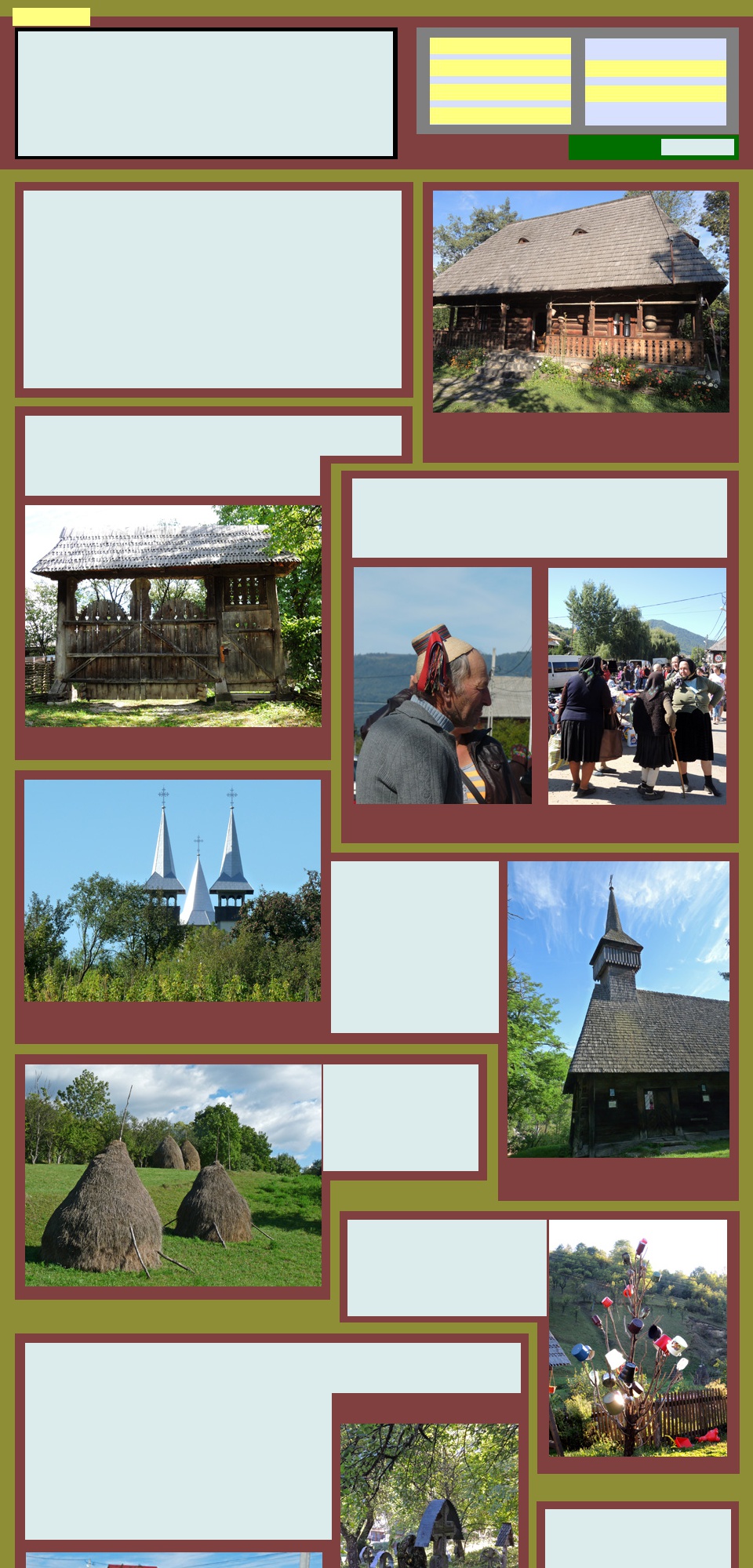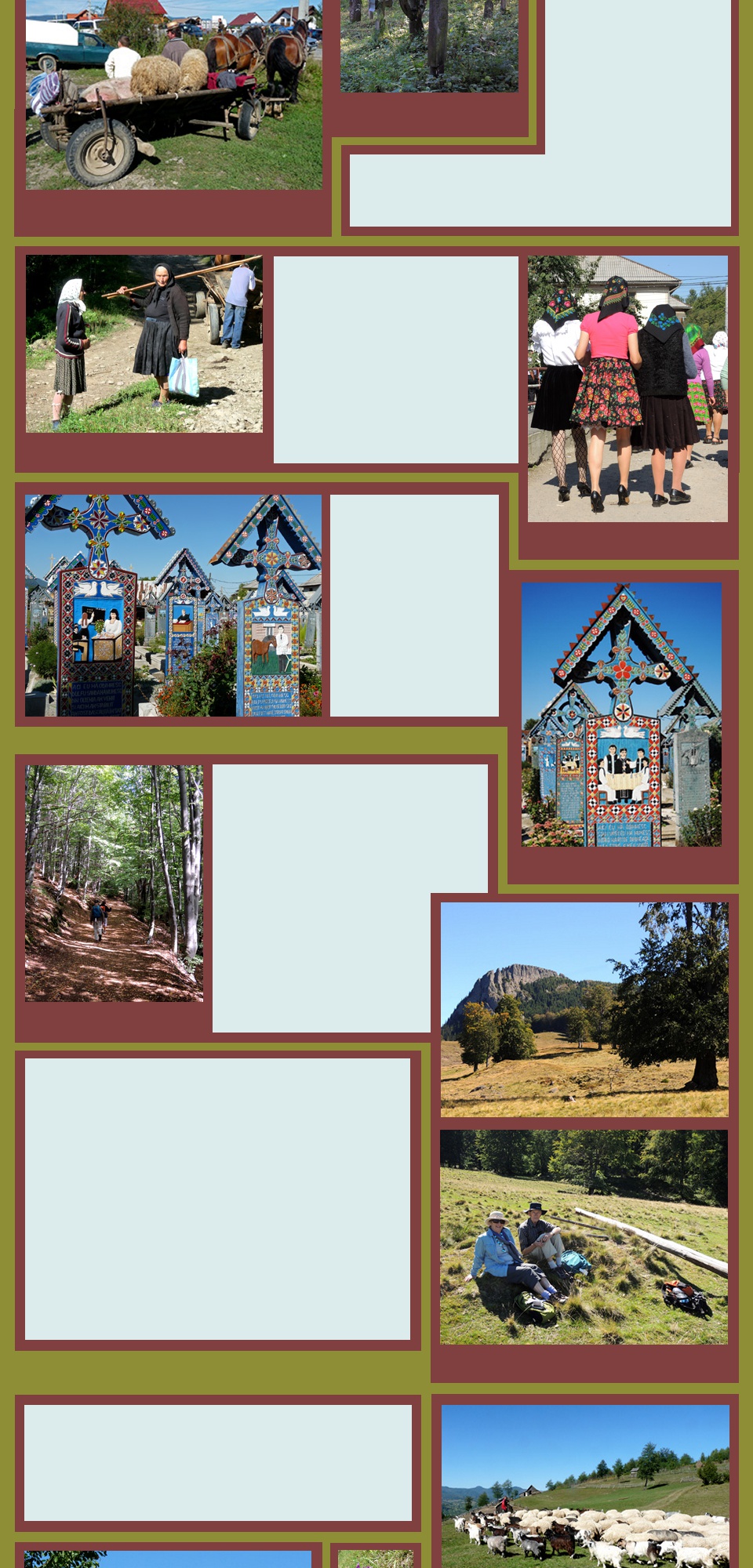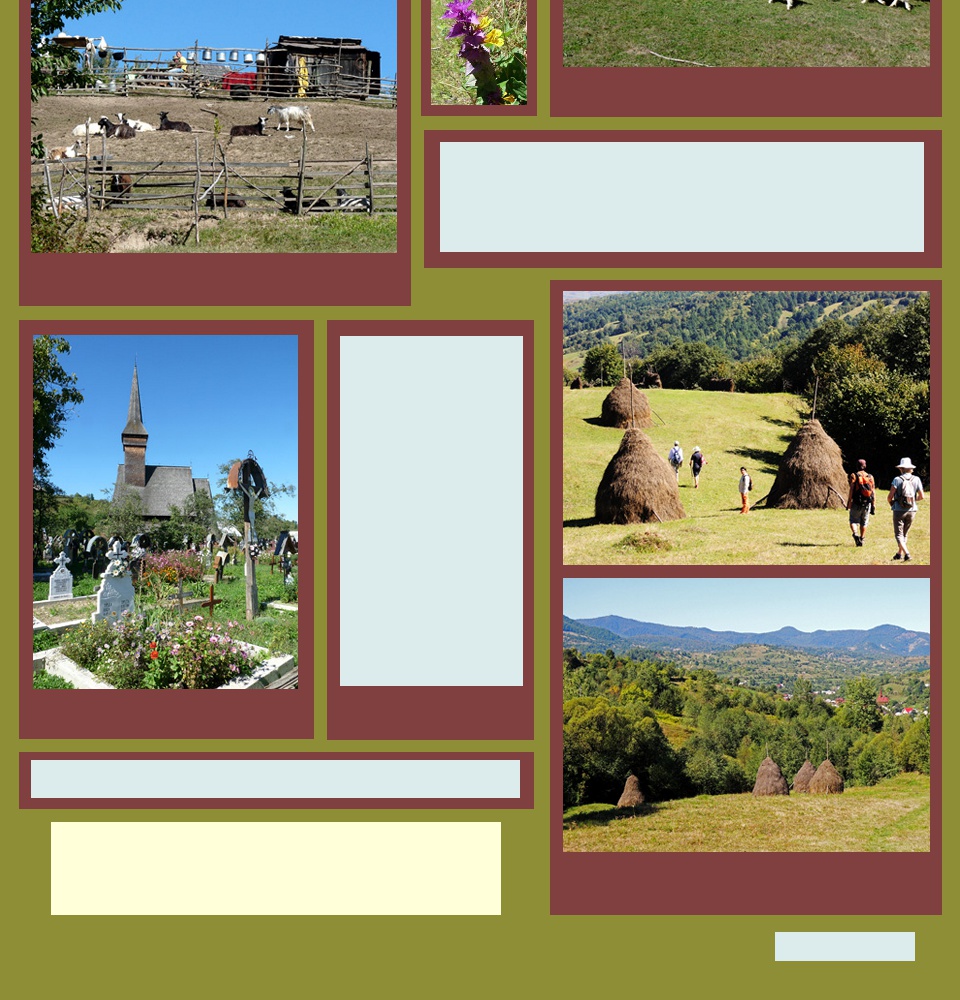Maramures
Rolling hills and village life
View pictures of
In Maramures it seems as if time has stood still. The Romans never made it
here but the Hungarians and the Tartars did and afterwards the region
endured the power struggles of the two world wars before finally settling back
into an isolated peasant culture. Ceausescu's regime had little impact but
here, as everywhere, people speak with relief that those times are gone.
In small villages the people live off the land, using wooden tools long
abandoned elsewhere in Europe. Horses and carts continue to be the main,
and often only, means of transport. Village markets are a colourful weekly
event where everything needed for this simple life is sold. Strong horses pull
the long, boat shaped carts that transport everything. Whole families climb up
to be transported to work in the mornings and home in the afternoons.
Mountains of hay and corn, long trunks of timber for firewood or building
construction, animals, general junk and even a frig and a broken down car
were some of the cargo we saw.
The women continue to wear their traditional costume - a short gathered skirt,
often colourful stockings and always, a headscarf. Some old ladies wear
traditional shoes - pointy toed slippers with broad laces that criss cross up the
leg over stockings. Most wear more practical sneakers. The men wear
conventional modern dress except for a curious little straw hat that perches
precariously on the top of their heads.
Traditional houses are crafted from wood, retreating behind huge decoratively
carved wooden gates that are like fortresses. Sadly these old houses are
succumbing to a desire for the comforts of garish modern houses with shiny
wrought iron gates. Old houses and gates are being sold,
Sometimes outside a house we saw
pot trees - spindly naked tree
branches with cooking pots
suspended on the branches to dry.
They told us that, if the top one is
white, there is a girl of marriageable
age living in the house.
Beautiful old wooden churches
are a feature in many villages
and a large number of these are
UNESCO World Heritage sites.
As seen in the houses, the
traditional craftsmanship in these
old churches is superb.
Some old churches are no longer
in use, now replaced by dazzling
new churches with shiny spires
and domes.
dismantled and reconstructed by those trying to preserve the
old crafts.
The rolling hillsides were
dotted with haystacks,
artfully constructed round a
central pole to look like
Indian tepees. Wooden
crosses were also a feature
in the landscape.
Villages in Maramures
The first village was Breb, a tiny hamlet distinguished by
lovely old wooden houses, majestic carved gates and two
churches, a very old wooden one and a shiny new one.
Alongside the churches were simple cemeteries with
beautifully crafted crosses sheltering under shady trees. We
had a spacious room in a typical village house surrounded by
gardens and a simple pot tree stood at the corner of the
veranda. We loved that the grand entrance gate had a pet
door.
We dined well here and had our first introduction to tuica, that
fiery plum brandy that starts every meal.
We stayed in two different villages in Maramures, accommodated in traditional houses which have been
tastefully adapted for tourism. Wholesome meals were prepared for us by the owners.
Nearby was the town of Ocna
Sugatag where the weekly village
market co-incided with our itinerary.
It was a very colourful affair. There
were horses, cows, big woolly sheep
and long haired goats and pigs of all
sizes for sale.
There were colourful fabrics and
woven belts and bags, brooms and
rakes, bags of grain, fruit and
vegetables, rugs and blankets and all
manner of clothes and footwear.
Horses, still harnessed into their
carts, waited patiently to take stuff
home.
In the village of Botiza we stayed in another delightful house that was one of a
group of rural buildings just outside the village. Woven fabrics and carpets
decorated our room and in pride of place was a huge ceramic stove that
pumped out heat on the chilly evenings. Around the house were apple and
pear trees laden with ripe fruit.
There was another lively and busy market in
Botiza but the real spectacle was on Sunday
morning when all the villagers dressed in their
best clothes to go to church. Old ladies wore a
lot of black and practical jumpers but the girls
and younger women were adorned in all the
colourful fabrics that were on display in the
markets.
There was definitely a competitive air here - still
the short gathered skirts but often topped with
frilly white blouses and we were amazed to
watch the precarious progress of some girls in
fashionable stiletto heels. All wore headscarves.
The men were dressed much more soberly.
One of the real highlights of
Maramures is the Merry
Cemetery in Sapanta. This is a
very unconventional cemetery
where every grave is embellished
with a cross and descriptive
panel painted in bright colours
with delightfully naive scenes
from the person's life. A
sometimes graphic and often
humorous account of the life of
the departed is carved onto the
panel. These tell us the person's
profession, favourite pastimes
and prized possessions and
present a refreshingly different
approach to the inevitability of
death.
From Breb we did our first walk, starting from the top of
the Gutai Pass which we had crossed on our journey
through the mountains to reach the region. The walk
began on a well formed forest track soon emerging into
open country along the ridges that looked down into the
valleys below. Our objective was a rocky outcrop called
the Creasta Cocoshului, or Cock's Comb, that could be
seen from miles around, looking ... just like a cock's
comb.
We had been told about bears and wolves
but we were to discover that the most
dangerous animals we were likely to
encounter were the shepherd's dogs that
guard flocks of sheep on the mountain
pastures. Sergiu, our guide, had a very
healthy respect for these dogs and told us
harrowing tales of his experiences while
guiding other walkers or trail bike groups.
Sure enough, as we enjoyed the scenery, we saw a mob of sheep about 500m
away and had our first encounter with these fearsome dogs. They saw us
coming, barked furiously and ran towards us, teeth barred. We all shouted in
different languages and they were discouraged but we weren't taking any
chances so we made a wide detour round the hillside. Sergiu encouraged us to
keep together and picked up some stones which he carried till we were out of
the danger zone.
The descent was a steep forestry road, very chopped up and very muddy. We
were now to discover the extent and importance of forestry, one of the
economic mainstays of this part of Romania. It is strictly controlled and we
saw a lot of it, not surprising given the widespread use of timber in building
construction. At this time of year there is also extensive harvesting for winter
firewood. The forests are pretty inaccessible and we were often to see horses
being used to drag out the big logs to trucks for transportation. All in all it
makes a terrible mess of all the forest roads and tracks.
Walking in Maramures
Breb to Mara
In this gentle rolling country we found a sheltered meadow for lunch before
descending towards the village of Mara, a small village with more photogenic
houses and impressive gates. There was a conveniently located small bar
where Dan joined us and we were introduced to Ciuc (pronounced chook) a
refreshing shandy style of drink.
After visiting the market in Botiza we walked across the hills to another village
called Ieud. On the outskirts of Botiza we passed rustic farmhouses where
wood was stacked up for the long winter ahead. Freshly shorn and washed
wool was hung out to dry ready for weaving and garlands of dried corn and
chilli were hung under the eaves of the roofs. We smiled our way between
peasants carrying wooden rakes and scythes and dodged horses and carts till
a climb took us round a hillside and up into rolling meadows with sweeping
views back down to the village.
Haystacks clustered on the hillsides and wooden huts were dotted about.
There was no track, just Ramona and Sergio's familiarity with the countryside.
We passed a yard where a flock of goats lay about, watching us with
disinterest. Pails of milk and heavy cheeses hung from the railings. A little
further on we passed a straggly flock of sheep and goats guided by a shepherd
and a couple of dogs. Far from being ferocious these dogs seemed quite
friendly.
A splendid lunch had been
packed for us and we ate
this high up on a ridge with
a vista towards the distant
mountains. Then an easy
walk wound down to Ieud
where there are two
churches. We visited the
oldest, in fact the oldest
wooden church in
Maramures which is not
used but being restored as
a monument. Dating from
1364, it is said to have
survived the Tartar's
attacks. Inside were
simple ochre coloured
paintings of saints and
bible stories. A glistening
iconostasis was under
repair.
Botiza to Ieud
Along a bumpy road, we were transported home again to our peaceful rural retreat.
Next day we travelled to Bucovina.
In further pages are descriptions of our experiences in
The cottage in Breb
Covered gateway in Breb
In the market in Ocna Sugatag
New church in Breb
Historic church in Breb
Cemetery
All purpose transport
Gossip
Sunday
Sapanta
Near the Gutai Pass
Creasta Cocoshului
Lunch
Near Botiza
The goat's milk dairy
Between Botiza and Ieud
Historic church in Ieud



